Plant of the Month: July 2005
|
| Wattle |
Acacia Mill.
|
(LEGUMINOSÆ; FABACEÆ or MIMOSACEÆ); Pea Family
|
| It is now fashionable in Seattle to spice up an otherwise drab routine landscape with some Southern warmth; to enliven the scene using plants that were not grown here in previous decades because Seattle winters are usually too cold for such tropical or subtropical plants. Examples include palms, eucalypts, bananas, agaves, cordylines, oleanders, and acacias. Choosing the right species, and siting them carefully, can make a Seattle garden look like it belongs to an owner longing for San Diego. |
| Sooner or later an old-fashioned winter will bring about a tempering dose of sober reality. The enthusiastic gardener will then possess exotic firewood, and heavy masses of blackened foliage from which choice compost can be made. Yet until the freeze strikes it is okay to do the equivalent of growing house-plants outdoors. |
The first edition of Trees of Seattle cited only Acacia melanoxylon, noting that two specimens at the University of Washington campus were killed to their roots in the winter of 1988-1989, but resprouted. Well, the Anderson Hall tree died later, and the one west of Bloedel Hall died back again --but resprouted again. It currently has about 18 stems/trunks and is 16 feet tall. It flowers and makes seeds. Other acacias will be added to my second edition of Trees of Seattle.
|
| The genus Acacia is very large. In fact, at some 1,200 species, few genera are larger. From D.J. Mabberley's The Plant Book I find that only four genera contain more species: Carex 2,000, Euphorbia 2,000, Astragalus 1,750, Senecio 1,250. Various other genera also have plants for which the common name acacia is used now and then. However, my present remarks refer exclusively to the genus Acacia, established in 1754 by Miller. Speaking broadly, Acacia species are mostly tropical trees and shrubs. The name Acacia is ancient Latin, from Greek akakia (applied to the Egyptian species A. Nilotica), from akis, a sharp point, referring to the thorns. |
| Most Acacia species are Australian, where the name wattle is used. Wattle is Australia's national emblem. The name arose because early settlers used the pliable saplings of some species to make "wattle-and-daub" structures. Yet E. Lord reports the tree most used as wattle was not a true Acacia at all, but Callicoma. Details . . . As for North American cultivation, Andre Michaux's Charleston nursery offered acacias sometime between 1787 and 1796. Very few species are frost-tolerant. They tend to grow rapidly, and to bloom while young, providing dramatic landscape impact quickly. Most have a short lifespan of 15 to 30 years. The seven species noted below are among the hardiest, and all have evergreen foliage. Acacia foliage is of two kinds: leaflike phyllodes, and finely pinnately compound feathery or ferny true leaves (like those of Albizia). Some species bear both kinds of foliage, others bear only one or the other kind. In general appearance most Acacia trees can be described as elegant, airy or fine rather than stodgy or coarse. Some are wonderfully colorful in bloom, others subtle. Their fruit is a dry seedpod. |
| As for cold-hardiness in Seattle, I suggest that the greatest success is apt to result if you plant your specimens when very young, in a drier and sunnier site. Planting larger specimens means you may be planting one with girdling roots. Planting in moist or irrigated gardens means its growth will be so rapid that it is likely to prove less cold hardy. Depending on the species, the size upon planting, the locale, the time of year, the weather that year, and such, an acacia tree in Seattle may grow 2 or even 6 or more feet in a year. But history shows that they will not long endure. If Fortune smiles upon you, your specimen may bloom and set seeds before it freezes. If not, it was still a fun experiment worth trying. |
Below are enumerated 7 species that I know are established in Seattle currently. I am aware of other shrubby ones, and some species known only in pots. You can help me update Trees of Seattle by alerting me of treelike, outdoors Acacia species you know of in Seattle. Thanks.
|
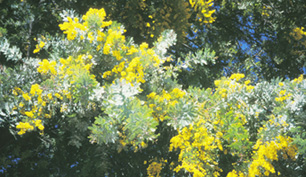
|
| A. Baileyana F.v. Muell. |
Cootamundra wattle. Bailey acacia or wattle. Fernleaf acacia. Golden mimosa. From the Cootamundra and Wagga districts of New South Wales. Naturalized elsewhere in Australia, as well as parts of California. Introduced to Europe in 1873, and to California by 1900. Named in 1884 after Frederic Manson Bailey (1827-1915), Queensland botanist. A small tree, to 30 feet tall and wide, of ferny, dusty-blue foliage and brilliant, fragrant, golden-yellow flowers in late winter or earliest spring. Drought-tolerant, it is best kept unwatered, and pruned heavily. The seedpods, 2 to 4 inches long, are an attractive purplish color when young. Variable cold-hardiness. Some can barely tolerate frost; some established trees show little harm at 20 degrees F, and can recover from 12 degrees F freezes. Acacia Baileyana f. purpurea hort. is the Purpleleaf acacia. It is a strain grown from selected seedlings, that first arose in L. Coates' nursery of California in the 1920s. New growth and pods lavender to purple, maturing to blue-gray. It may be more cold-hardy than the typical form. Two Purpleleaf acacias are planted at 2305 NW 100th St (the North Beach neighborhood).
|
| A. dealbata Link |
| = A. decurrens var. dealbata (Link) F.v. Muell. |
Silver wattle. From E New South Wales, Victoria, and Tasmania. Naturalized in the Mediterranean region, as well as parts of California. Introduced to cultivation as early as 1792, to England in 1818, to France in 1824; in the California nursery trade by 1853. In France it was first thought exclusively a greenhouse subject; its immense appeal made it popular, but its vigor kept putting it literally "through the roof," so by the 1840s it was tested outdoors and was found surprisingly frost-hardy. Outside, in three years it can attain 16 or 20 feet in height, and blossom. Its flowers, highly scented, are the "golden mimosa" of florists. The name mimosa is from Greek mimos, a mimic or imitator: the leaflets mimic a wilted leaf by closing down when touched. Compared to Acacia Baileyana, this species is much larger, hardier, bigger-leaved, later-blooming, longer-lived, and not so pale-bluish. It is more closely related to Acacia decurrens, differing primarily in color of foliage: Latin dealbatus means covered with a white powder --referring to the whitish-hairy young shoots and leaves. The clusters of small ball-like golden flowers appear from February into May. Seedpods are pale, 2 to 4 inches long. As an ornamental, Silver wattle is not without blemishes, being liable to fall over, to send forth root-suckers, let alone being killed occasionally by freezing. Above all, it grows awkwardly large in a hurry. It has been recorded to 147 feet tall by 15 feet in trunk circumference in Australia. In Seattle, one planted in October 2002 at 9329 Lima Terrace S is now about 25 feet tall.
|
| A. longifolia (Andrews) Muhl. ex Willd. |
Sydney golden wattle. Sallow wattle. Long-leaved wattle. From SE Australia. Named in 1806. A shrub or at most a 33 foot tree. The "leaves" (phyllodes) are up to 5 inches long by over an inch wide. The flowers are lemon-yellow. At the U.W. campus some are mixed with Acacia melanoxylon specimens south of the West Campus parking garage. The tallest are 26 feet. They are darker and bear wider "leaves" (phyllodes) (no ferny foliage) than the Acacia melanoxylon specimens.
|
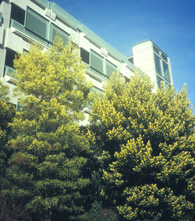
|
| A. melanoxylon R. Br. |
Blackwood. Australian blackwood. Tasmanian blackwood. Blackwood acacia. Black acacia. From SE Australia and Tasmania. Introduced to cultivation in 1808; to California by 1858, and naturalized in some places there. Name derived from Greek melas, black, and xylon, wood. The bark is rough, dark gray, and the highly valued wood is dark. Compared to the other six acacias in this account, Blackwood is more of a long-lived shade tree, less of a short-lived "flowering" tree. Root-suckering is a problem. It bears dense billowy masses of comparatively dark, leafy foliage, tinted silvery-purplish in winter. Ferny pinnate foliage is borne only on saplings. The "leaves" (phyllodes) are up to 6 inches long by an inch wide, but most are less than 5 inches by five-eighths. Flowers creamy-whitish to very pale yellow, in short clusters primarily in March. Seedpods 2 to 5 inches long, markedly twisted or coiled, and slightly constricted between the seeds. Overall, a tough species; severe freezes kill it. It tolerates wet conditions better than most acacias. It has been recorded to 147 feet tall by 31 feet in trunk circumference in Australia. The U.W. has one 16 feet tall above the Burke-Gilman Trail west of Bloedel Hall. Some are mixed with Acacia longifolia trees south of the West Campus parking garage, the tallest about 22 feet. Washington Park Arboretum has some dating from 1989 in quadrant 21-3E, that are 25 and 31 feet tall. All of these U.W. and arboretum specimens have died to the ground before and resprouted.
|
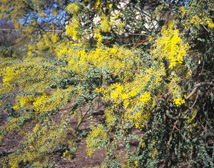
|
| A. pravissima F.v. Muell. ex Benth. |
Screwpod acacia. Ovens wattle. Wedge-leaf wattle. Alpine wattle. Tumut wattle. From NE Victoria, New South Wales, and A.C.T. Named in 1853. Introduced to California by 1897; less well-known than many acacias, but definitely promising for Seattle. Its specific epithet means "very twisted" --from Latin pravus, crooked, and the superlative -issima, very crooked or twisted. A shrubby little tree with slender whiplike twigs bearing highly distinctive sage-green, dull, dryish-feeling tiny (half-inch) "leaves" (phyllodes) of broadly triangular shape. The branches are partly pendulous, so the foliage rustles as it sways. Bright clear yellow flowers in February-March. Seedpods 3 to 4 inches long. Records: to 42 feet tall in Australia. A few in Seattle yards: 122 17th Ave E (south side of front yard); 4340 NE 55th St (SE corner of the yard); 8517 8th Ave NE.
|
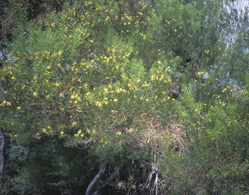
|
| A. retinodes Schltdl. |
Everblooming acacia. Wirilda. Swamp wattle. Water wattle. From Tasmania, Victoria, and S Australia. Introduced to California in 1871; naturalized in some places there. The specific epithet (also spelled rhetinodes) from the Greek rhetine, resin, meaning resinous, refers to its gum-yielding properties. A shrub or small open-crowned tree 20 to 33 feet tall, with long, pale to dark green, very narrow "leaves" (phyllodes) 5 to 9 inches long by half an inch or much less wide. Notable for bearing flowers nearly all year around, but mostly in the summer and autumn. Flowers small, pale yellow, less showy than those of most cultivated species. Seedpods 1.25 to 5.5 (8) inches long, only a third of an inch wide. Fast-growing, but brittle and short-lived; rarely more than 20 years old. One several years old is on Beacon Hill in a back yard, not visible from the street. I planted one this month in my Montlake garden that by and by will be visible from the sidewalk.
|
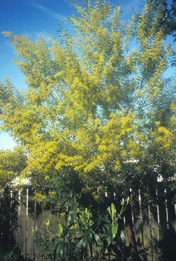
|
| A. rubida A. Cunn. |
Red-leaf or Red-stemmed wattle. From SE Australia. Named in 1825. A shrub merely 5 feet tall, or small tree 15 feet (42 feet at most). The twigs are often reddish; the phyllodes are from 2 to 8 inches long, at most an inch wide. A bit of ferny pinnate foliage is present. The flowers are light golden. In October 2002 a specimen was planted at 9329 Lima Terrace S; it produced seeds in 2005. It is just north of the larger A. dealbata. One in a north Seattle garden was producing self-sown seedlings, but was cut down.
Back |
|
|

